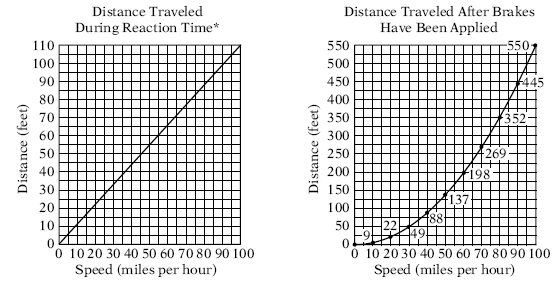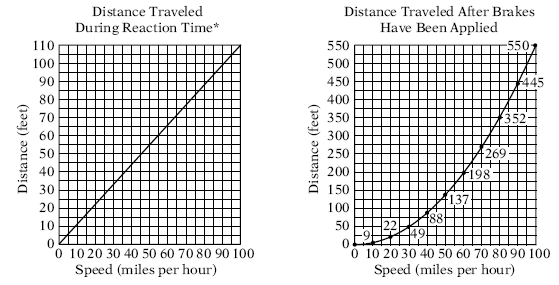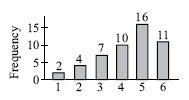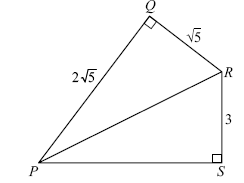GRE Mock Test (New Pattern) - 10 - GRE MCQ
30 Questions MCQ Test - GRE Mock Test (New Pattern) - 10
Directions: Choose the word or set of words that best completes the following sentence.
Many people criticized the mayor’s decision to ban sugary drinks. However, a small group __________ his efforts to intertwine public health and public policy.
Directions: Answer the questions based on following reading passage.
Arctic sea ice comes in two varieties. Seasonal ice forms in winter and then melts in summer, while perennial ice persists year-round. To the untrained eye, all sea ice looks similar, but by licking it, one can estimate how long a particular piece has been floating around. When ice begins to form in seawater, it forces out salt, which has no place in the crystal structure. As the ice gets thicker, the rejected salt collects in tiny pockets of brine too highly concentrated to freeze. A piece of first-year ice will taste salty. Eventually, if the ice survives, these pockets of brine drain out through fine, veinlike channels, and the ice becomes fresher; multiyear ice can even be melted and drunk.
Q. In the context in which it appears, “fine” (line 7) most nearly means
Coetzee is known to be reclusive, and he __________ publicity to such an extent that he did not collect either of his two Booker Prizes in person.
A. welcomes
B. avoids
C. courts
D. shuns
E. gathers
F. tries
Even though Magellan would eventually die on his ambitious cruise around the world, nothing was ______ on the morning of his departure from his home port.
A. innocuous
B. portentous
C. propitious
D. amiss
E. auspicious
F. ingenuous
Since the invention of computers, chips and processors have become smaller and simpler, but computer programs have become increasingly _________.
A. anomalous
B. efficient
C. byzantine
D. treacherous
E. labyrinthine
F. intransigent
Directions: Answer the questions based on following reading passage.
Until recently, many anthropologists assumed that the environment of what is now the southwestern United States shaped the social history and culture of the region’s indigenous peoples. Building on this assumption, archaeologists asserted that adverse environmental conditions and droughts were responsible for the disappearances and migrations of southwestern populations from many sites they once inhabited.
However, such deterministic arguments fail to acknowledge that local environmental variability in the Southwest makes generalizing about that environment difficult. To examine the relationship between environmental variation and sociocultural change in the Western Pueblo region of central Arizona, which indigenous tribes have occupied continuously for at least 800 years, a research team recently reconstructed the climatic, vegetational, and erosional cycles of past centuries. The researchers found it impossible to provide a single, generally applicable characterization of environmental conditions for the region. Rather, they found that local areas experienced different patterns of rainfall, wind, and erosion, and that such conditions had prevailed in the Southwest for the last 1,400 years. Rainfall, for example, varied within and between local valley systems, so that even adjacent agricultural fields can produce significantly different yields.
The researchers characterized episodes of variation in southwestern environments by frequency: low-frequency environmental processes occur in cycles longer than one human generation, which generally is considered to last about 25 years, and high frequency processes have shorter cycles. The researchers pointed out that low-frequency processes, such as fluctuations in stream flow and groundwater levels, would not usually be apparent to human populations. In contrast, high-frequency fluctuations such as seasonal temperature variations are observable and somewhat predictable, so that groups could have adapted their behaviors accordingly. When the researchers compared sequences of sociocultural change in the Western Pueblo region with episodes of low- and high-frequency environmental variation, however, they found no simple correlation between environmental process and sociocultural change or persistence.
Although early Pueblo peoples did protect themselves against environmental risk and uncertainty, they responded variously on different occasions to similar patterns of high frequency climatic and environmental change. The researchers identified seven major adaptive responses, including increased mobility, relocation of permanent settlements, changes in subsistence foods, and reliance on trade with other groups. These findings suggest that groups’ adaptive choices depended on cultural and social as well as environmental factors and were flexible strategies rather than uncomplicated reactions to environmental change. Environmental conditions mattered, but they were rarely, if ever, sufficient to account for sociocultural persistence and change. Group size and composition, culture, contact with other groups, and individual choices and actions were— barring catastrophes such as floods or earthquakes—more significant for a population’s survival than were climate and environment.
Q. It can be inferred from the passage that which of the following activities is NOT an example of a population responding to high-frequency environmental processes?
Directions: Answer the questions based on following reading passage.
Until recently, many anthropologists assumed that the environment of what is now the southwestern United States shaped the social history and culture of the region’s indigenous peoples. Building on this assumption, archaeologists asserted that adverse environmental conditions and droughts were responsible for the disappearances and migrations of southwestern populations from many sites they once inhabited.
However, such deterministic arguments fail to acknowledge that local environmental variability in the Southwest makes generalizing about that environment difficult. To examine the relationship between environmental variation and sociocultural change in the Western Pueblo region of central Arizona, which indigenous tribes have occupied continuously for at least 800 years, a research team recently reconstructed the climatic, vegetational, and erosional cycles of past centuries. The researchers found it impossible to provide a single, generally applicable characterization of environmental conditions for the region. Rather, they found that local areas experienced different patterns of rainfall, wind, and erosion, and that such conditions had prevailed in the Southwest for the last 1,400 years. Rainfall, for example, varied within and between local valley systems, so that even adjacent agricultural fields can produce significantly different yields.
The researchers characterized episodes of variation in southwestern environments by frequency: low-frequency environmental processes occur in cycles longer than one human generation, which generally is considered to last about 25 years, and high frequency processes have shorter cycles. The researchers pointed out that low-frequency processes, such as fluctuations in stream flow and groundwater levels, would not usually be apparent to human populations. In contrast, high-frequency fluctuations such as seasonal temperature variations are observable and somewhat predictable, so that groups could have adapted their behaviors accordingly. When the researchers compared sequences of sociocultural change in the Western Pueblo region with episodes of low- and high-frequency environmental variation, however, they found no simple correlation between environmental process and sociocultural change or persistence.
Although early Pueblo peoples did protect themselves against environmental risk and uncertainty, they responded variously on different occasions to similar patterns of highfrequency climatic and environmental change. The researchers identified seven major adaptive responses, including increased mobility, relocation of permanent settlements, changes in subsistence foods, and reliance on trade with other groups. These findings suggest that groups’ adaptive choices depended on cultural and social as well as environmental factors and were flexible strategies rather than uncomplicated reactions to environmental change. Environmental conditions mattered, but they were rarely, if ever, sufficient to account for sociocultural persistence and change. Group size and composition, culture, contact with other groups, and individual choices and actions were— barring catastrophes such as floods or earthquakes—more significant for a population’s survival than were climate and environment.
Q. The passage is primarily concerned with
Directions: Answer the questions based on following reading passage.
Until recently, many anthropologists assumed that the environment of what is now the southwestern United States shaped the social history and culture of the region’s indigenous peoples. Building on this assumption, archaeologists asserted that adverse environmental conditions and droughts were responsible for the disappearances and migrations of southwestern populations from many sites they once inhabited.
However, such deterministic arguments fail to acknowledge that local environmental variability in the Southwest makes generalizing about that environment difficult. To examine the relationship between environmental variation and sociocultural change in the Western Pueblo region of central Arizona, which indigenous tribes have occupied continuously for at least 800 years, a research team recently reconstructed the climatic, vegetational, and erosional cycles of past centuries. The researchers found it impossible to provide a single, generally applicable characterization of environmental conditions for the region. Rather, they found that local areas experienced different patterns of rainfall, wind, and erosion, and that such conditions had prevailed in the Southwest for the last 1,400 years. Rainfall, for example, varied within and between local valley systems, so that even adjacent agricultural fields can produce significantly different yields.
The researchers characterized episodes of variation in southwestern environments by frequency: low-frequency environmental processes occur in cycles longer than one human generation, which generally is considered to last about 25 years, and high frequency processes have shorter cycles. The researchers pointed out that low-frequency processes, such as fluctuations in stream flow and groundwater levels, would not usually be apparent to human populations. In contrast, high-frequency fluctuations such as seasonal temperature variations are observable and somewhat predictable, so that groups could have adapted their behaviors accordingly. When the researchers compared sequences of sociocultural change in the Western Pueblo region with episodes of low- and high-frequency environmental variation, however, they found no simple correlation between environmental process and sociocultural change or persistence.
Although early Pueblo peoples did protect themselves against environmental risk and uncertainty, they responded variously on different occasions to similar patterns of high frequency climatic and environmental change. The researchers identified seven major adaptive responses, including increased mobility, relocation of permanent settlements, changes in subsistence foods, and reliance on trade with other groups. These findings suggest that groups’ adaptive choices depended on cultural and social as well as environmental factors and were flexible strategies rather than uncomplicated reactions to environmental change. Environmental conditions mattered, but they were rarely, if ever, sufficient to account for sociocultural persistence and change. Group size and composition, culture, contact with other groups, and individual choices and actions were— barring catastrophes such as floods or earthquakes—more significant for a population’s survival than were climate and environment.
Q. Which of the following findings would most strongly support the assertion made by the archaeologists mentioned in line 3?
Directions: Choose the word or set of words that best completes the following sentence.
It was very difficult to guess what Justin would say, for he could engage in both __________ and understatement within a three-second interval.
Directions: Choose the word or set of words that best completes the following sentence.
Ronald's friends were surprised at his recent __________ behavior, for they knew him to be a man of scrupulous conscience.
Directions: Choose the word or set of words that best completes the following sentence.
Although the boy was known for walking briskly everywhere he went, today he traveled at a pace that was quite __________.
Directions: Choose the word or set of words that best completes the following sentence.
Although he seemed quite inflexible, Thomas was quite __________ and able to deal with any situation that came his way.
Directions: Answer the questions based on following reading passage.
Historians credit repeated locust invasions in the nineteenth century with reshaping United States agriculture west of the Mississippi River. Admonished by government entomologists, farmers began to diversify. Wheat had come to nearly monopolize the region, but it was particularly vulnerable to the locusts. In 1873, just before the locusts’ most withering offensive, nearly two-thirds of Minnesota farmland was producing wheat; by the invasions’ last year, that fraction had dropped to less than one-sixth. Farmers learned that peas and beans were far less vulnerable to the insects, and corn was a more robust grain than wheat. In addition to planting alternative crops, many farmers turned to dairy and beef production. Although pastures were often damaged by the locusts, these lands were almost always left in better shape than the crops were.
Q. In the context in which it appears, “robust” (line 8) most nearly means
Directions: Answer the questions based on following reading passage.
Historians credit repeated locust invasions in the nineteenth century with reshaping United States agriculture west of the Mississippi River. Admonished by government entomologists, farmers began to diversify. Wheat had come to nearly monopolize the region, but it was particularly vulnerable to the locusts. In 1873, just before the locusts’ most withering offensive, nearly two-thirds of Minnesota farmland was producing wheat; by the invasions’ last year, that fraction had dropped to less than one-sixth. Farmers learned that peas and beans were far less vulnerable to the insects, and corn was a more robust grain than wheat. In addition to planting alternative crops, many farmers turned to dairy and beef production. Although pastures were often damaged by the locusts, these lands were almost always left in better shape than the crops were.
Q. According to the passage, before the recommendations by the government entomologists, which of the following was true about farming west of the Mississippi River?
[For the following question, consider each of the choices separately and select all that apply.]
When Jeff fell prey to an on-line credit card scam, the sting of ________ hurt him more than the loss of money.
A. suffering
B. duplicity
C. faithlessness
D. falsehood
E. deception
F. indigence
In order to stop the uproar on social media that was ______ by the politician's unpopular comment, his press agent had to issue a public apology.
A. exacerbated
B. precipitated
C. precluded
D. triggered
E. prevaricated
F. goaded
Directions: Answer the questions based on following reading passage.
In Gilavia, the number of reported workplace injuries has declined 16 percent in the last five years. However, perhaps part of the decline results from injuries going unreported: many employers have introduced safety-incentive programs, such as prize drawings for which only employees who have a perfect work-safety record are eligible. Since a workplace injury would disqualify an employee from such programs, some employees might be concealing injury, when it is feasible to do so.
Q. Which of the following, if true in Gilavia, most strongly supports the proposed explanation?
Directions: Select one of the following answer choices.
Quantity A: 3-1 / 4-1
Quantity B: 4/3
Directions: Select one of the following answer choices.
Q. x < 1 and x ≠ 0
Quantity A: x2 + 1
Quantity B: x3 + 1
Directions: Select one of the following answer choices.
Q. x > 0
Quantity A: 0.5% of x
Quantity B: 1/2x
Directions: Select one of the following answer choices.
Q. The median income of a group of College C graduates six months after graduation was $3,000 higher than the median income of a group of College D graduates six months after graduation.
Quantity A: The 75th percentile of the incomes of the group of College C graduates six months after graduation
Quantity B: The 75th percentile of the incomes of the group of College D graduates six months after graduation
In year Y, the population of Colorado was approximately half that of New Jersey, and the land area of Colorado was approximately 14 times that of New Jersey. The population density (number of persons per unit of land area) of Colorado in year Y was approximately how many times the population density of New Jersey?
Distance Traveled By a Car According to The Car’s Speed When The Driver is Signaled to Stop

*Reaction time is the time period that begins when the driver is signaled to stop and ends when the driver applies the brakes.
Note: Total stopping distance is the sum of the distance travelled during reaction time and the distance travelled after brakes have been applied.
Q. The speed, in miles per hour, at which the car travels a distance of 52 feet during reaction time is closest to which of the following?
Distance Traveled By a Car According to The Car’s Speed When The Driver is Signaled to Stop

*Reaction time is the time period that begins when the driver is signaled to stop and ends when the driver applies the brakes.
Note: Total stopping distance is the sum of the distance travelled during reaction time and the distance travelled after brakes have been applied.
Q. Of the following, which is the greatest speed, in miles per hour, at which the car can travel and stop with a total stopping distance of less than 200 feet?
If 0 < a < 1 < b, which of the following is true about the reciprocals of a and b?
What is the least positive integer that is not a factor of 25! and is not a prime number?
Directions: Select one of the following answer choices.
Q. The graph below shows the frequency distribution of 50 integer values varying from 1 to 6.

Quantity A: The average (arithmetic mean) of the 50 values
Quantity B: The median of the 50 values
Directions: Select one of the following answer choices.
Q.

Quantity A: The area of triangle PQR
Quantity B: The area of triangle PSR
Directions: Select one of the following answer choices.
Quantity A: The sum of the odd integers from 1 to 199
Quantity B: The sum of the even integers from 2 to 198
Directions: Select one of the following answer choices.
Q. s and t are positive integers, and 32s = 2t .
Quantity A: s/t
Quantity B: 1/5




















